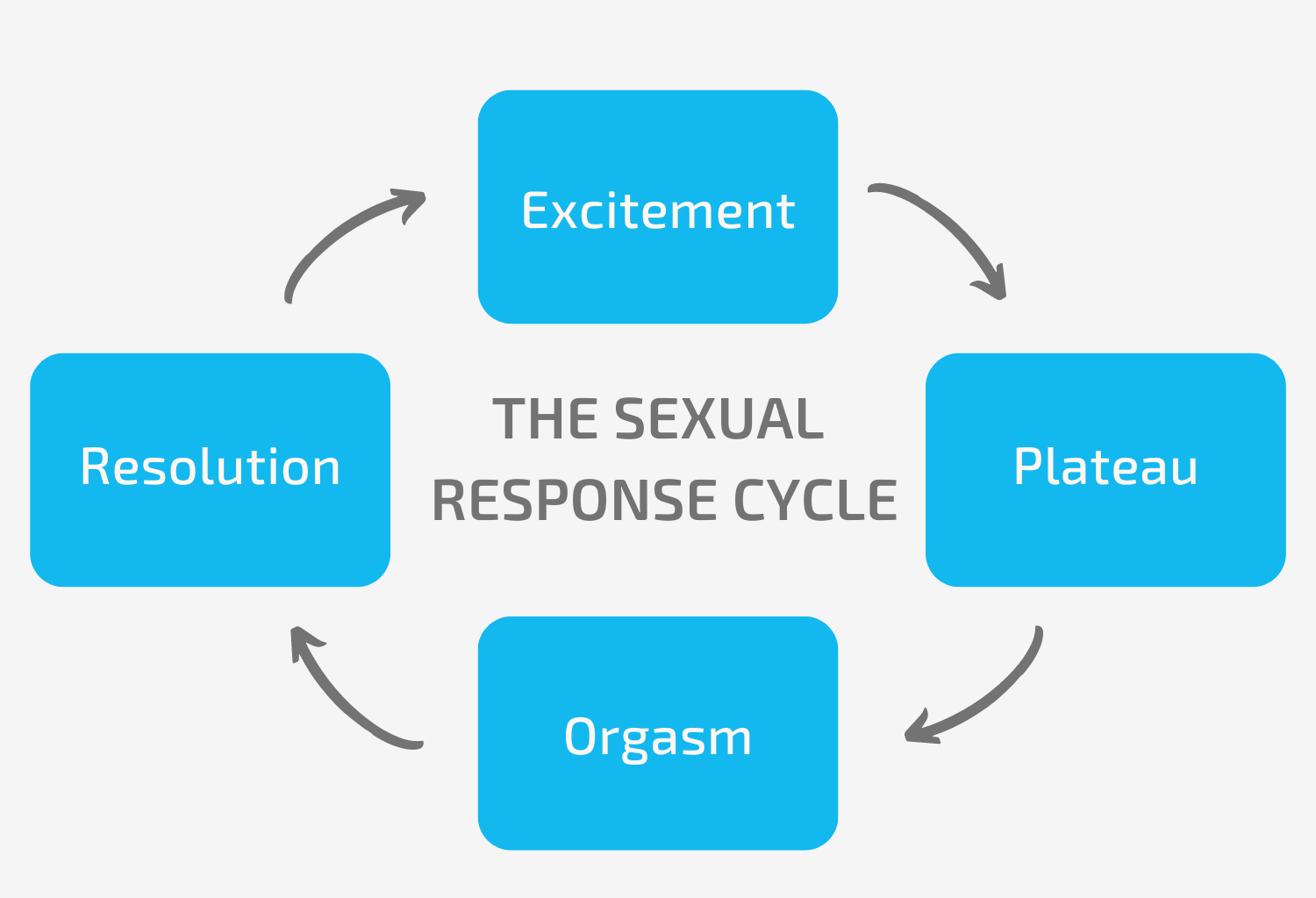Humans experience an array of responses and reactions during sexual intimacy. Some of the sensations we feel during sexual activity can be subtle for example, changes to breathing patterns or an elevated heart rate. While other responses, such as muscle contractions prior to orgasm can be more noticeable.
Regardless of their magnitude, every sexual response we experience during intimacy has its place in the Sexual Response Cycle (SRC). This cycle plots the sensations experienced by individuals during sex into one of its four stages.
Understanding the sexual response cycle can help improve our knowledge of the feelings we experience during sex. Not only does this allow us to get an insight into our own behaviors, but it can help us understand how our partners feel during intimacy. This article takes a deep dive into the sexual response cycle and explores each of its four stages.
What is the sexual response cycle?
The sexual response cycle refers to the physical and psychological changes that individuals experience when participating in sexual activity. The cycle can be broken down into the following stages: excitement, plateau, orgasm, and resolution.
The cycle stages typically happen in sequence. However, there may be some instances in which individuals don’t complete the cycle. This can be due to both physical and mental factors, such as chronic pain or mental health conditions. We explore some of the possible disruptions to the SRC later in this article.
The sexual response cycle is in effect during sexual activity with a partner or when masturbating alone.
Both males and females experience the sexual response cycle, although they may not undergo each stage simultaneously. For example, it’s rare for males and females to reach orgasm at the same time. Each stage of the sexual response cycle has been highlighted below.

Phase 1: Excitement
The excitement phase is the first stage of the sexual response cycle. During this phase individuals may be using their imagination, kissing, or being in early sexual contact with a partner. This stage can last minutes or even hours and may be experienced when fantasizing about a future sexual encounter.
During this stage, individuals will experience a variety of changes in accordance with their bodies preparing for sexual intercourse.
Men can expect to experience the following sexual responses in the excitement phase:
- An increase in muscle tension and muscle contractions in the pelvic region.
- The penis begins to form an erection and may alternate between a near-flaccid and erect state for the duration of the stage.
- An increase in the individual’s heart rate and breathing speed is common.
- Some individuals may experience red flushes (also known as sex flushes).
Phase 2: Plateau
The second stage of the sexual response cycle is the plateau phase, which sees individuals experience many of the same sensations from the first phase but now heightened. The plateau phase can last a number of minutes to hours and is in effect until individuals reach the orgasm stage.
During the plateau, the individual is likely to be undergoing intensely pleasurable sexual activity such as foreplay or full sexual intercourse.
During the plateau, the individual is likely to be undergoing intensely pleasurable sexual activity such as foreplay or full sexual intercourse. This phase of the cycle sees men getting ready to achieve an orgasm and they can expect to experience:
- Heavy breathing or panting.
- An elevated heart rate, especially if undergoing a lot of physical strain during sex.
- A firm and full erection can feel more and more sensitive as an individual nears the orgasm stage.
- The muscles located at the base of the penis may start to regularly contract in preparation for orgasm.
Phase 3: Orgasm
Perhaps the most important driving factor in male sexual behavior is orgasm. This stage of the sexual response cycle is considered the peak of sexual pleasure and is achieved after sustained periods of sexual stimulation.
Sexual dysfunction can be a barrier or even prevent this stage from occurring.
Orgasm difficulties include reaching orgasm too soon or not at all. Such difficulties can reduce sexual enjoyment and also limit a partner’s ability to reach their own orgasm. In some cases, men may not be able to maintain an erection for long enough to achieve an orgasm (known as erectile dysfunction).
When an orgasm is successfully achieved, men will experience the following:
- A highly pleasurable release of sexual tension (known as an orgasm) will take place.
- This is a sensation that typically lasts a matter of seconds and occurs just once, although some men report the ability to achieve multiple orgasms.
- Ejaculation (the expulsion of semen from the tip of the penis) is likely to occur right after reaching orgasm.
- The next stage of the cycle (resolution) will begin immediately after orgasm.
Although the male orgasm often coincides with ejaculation, it should be noted that orgasm and ejaculation are separate physiological functions.
Phase 4: Resolution
The final stage is known as resolution and this takes place after the orgasm has occurred. For men, the resolution phase is the period between reaching orgasm and being ready to be sexually aroused again. When men are going through the resolution stage, they won’t be able to feel sexually aroused. Any attempted stimulation is likely to be futile and may even cause pain rather than pleasure.
The resolution stage is also known as the refractory period and varies in length on an individual basis.
The resolution stage is also known as the refractory period and varies in length on an individual basis. For some, it can last minutes while others can take hours or even days. Research suggests that a man’s refractory period is likely to increase with age. During the resolution stage, the following takes place:
- The penis will return to a flaccid state.
- Men will not be able to become aroused or regain an erection even with stimulation.
- If men ejaculate early they will not be physically capable of continuing intercourse.
- The individual will remain unable to become aroused or erect until the resolution phase is over.
What can disrupt the cycle?
The sexual response cycle is a great way to map out sexual responses in humans. However, there are some instances where disruptions prevent the SRC from being complete. The sexual response cycle can be disrupted for any number of reasons ranging from mental health issues to physical pain.
We’ve highlighted some examples of disruptions to the sexual response cycle and what can be done about them in the table below:
|
DISRUPTION |
DESCRIPTION |
SOLUTION |
|
Anxiety and depression |
Anxiety/depression can cause individuals to lose interest in sexual activity. |
Communicate the issue to your partner and seek medical guidance for managing the condition. |
|
Physical pain |
Physical pain can be a major deterrent to sexual activity and may be a result of soreness from too much sex, or due to an unrelated condition such as chronic pain. |
Individuals who believe they are in too much pain to undergo sexual activity should refrain from doing so. Medical guidance should be sought out as required. |
|
Low libido |
A low sex drive can prevent individuals from seeking out sexual pleasure and stimulation. |
Communicate the issue to your partner and look to address libido issues by getting a medical assessment. |
|
Erectile dysfunction |
The inability to maintain an erection can lead to individuals struggling to reach the orgasm stage of the sexual response cycle. |
Seek medical assistance for erectile issues and be sure to communicate the issue to your partner. |
|
Ejaculation issues |
Ejaculation issues such as delayed ejaculation can be a strong disruption for the SRC. Alternatively, premature ejaculation may disrupt your partner's sexual response cycle. |
Consult a medical professional for advice on treating the condition. Ejaculation issues may cause sexual partners to feel self-conscious so make sure they are aware of the issue. |
The importance of going through every phase of the cycle
The sexual response cycle offers more than just a way to plot our sexual reactions during each stage of intimacy. By completing the SRC, an individual gets to experience the joy of every stage, and reach the all-important orgasm. From a biological standpoint, being able to successfully work through the SRC is crucial. Achieving an orgasm (which often coincides with ejaculation) is crucial for reproduction and completing the resolution phase allows an individual to begin the cycle again.
FAQ’s
What are the 4 stages of the sexual response cycle in order?
The four stages of the sexual response cycle are excitement, plateau, orgasm and resolution. These stages occur sequentially and can be repeated again after the completion of the resolution phase.
Which phase of the sexual response cycle can last longest?
Although the excitement and arousal stages can last a significant amount of time, the resolution phase is likely to be the longest possible stage of the cycle. This is because as men get older, their refractory periods often increase and can last days in some cases.
Which is the shortest phase in the sexual response cycle?
Unfortunately, the shortest phase in the sexual response cycle is also the most pleasurable: the orgasm. Even with the most intense and prolonged build-ups, individuals only have orgasms for a matter of seconds before moving on to the resolution phase.
Is the sexual response cycle different for males and females?
Although both males and females go through the sexual response cycle, there are some notable differences between sexes. Males and females can respond differently during the same stage of the cycle. Examples include men often ejaculating during the orgasm stage, while female ejaculation is less likely (known as squirting). Men and women may have different chances of completing the sexual response cycle. Some studies suggest that men are more likely to experience an orgasm during intercourse when compared to women.
Summary
The sexual response cycle is used to define how humans react during sexual activity, with each stage of the cycle able to map out a human’s sexual response.
The four phases of the sexual response cycle are excitement, plateau, orgasm and resolution.
Although ideally, humans would look to successfully complete and repeat the cycle, this isn’t always possible. Barriers can disrupt the cycle which may include (but are not limited to) mental health conditions, physical health difficulties and sexual dysfunctions. If you believe that you have a health issue that’s preventing you from successfully completing the sexual response cycle, be sure to consult a medical professional for guidance. Although this article is intended to be informative, it cannot be considered a substitute for medical advice.

